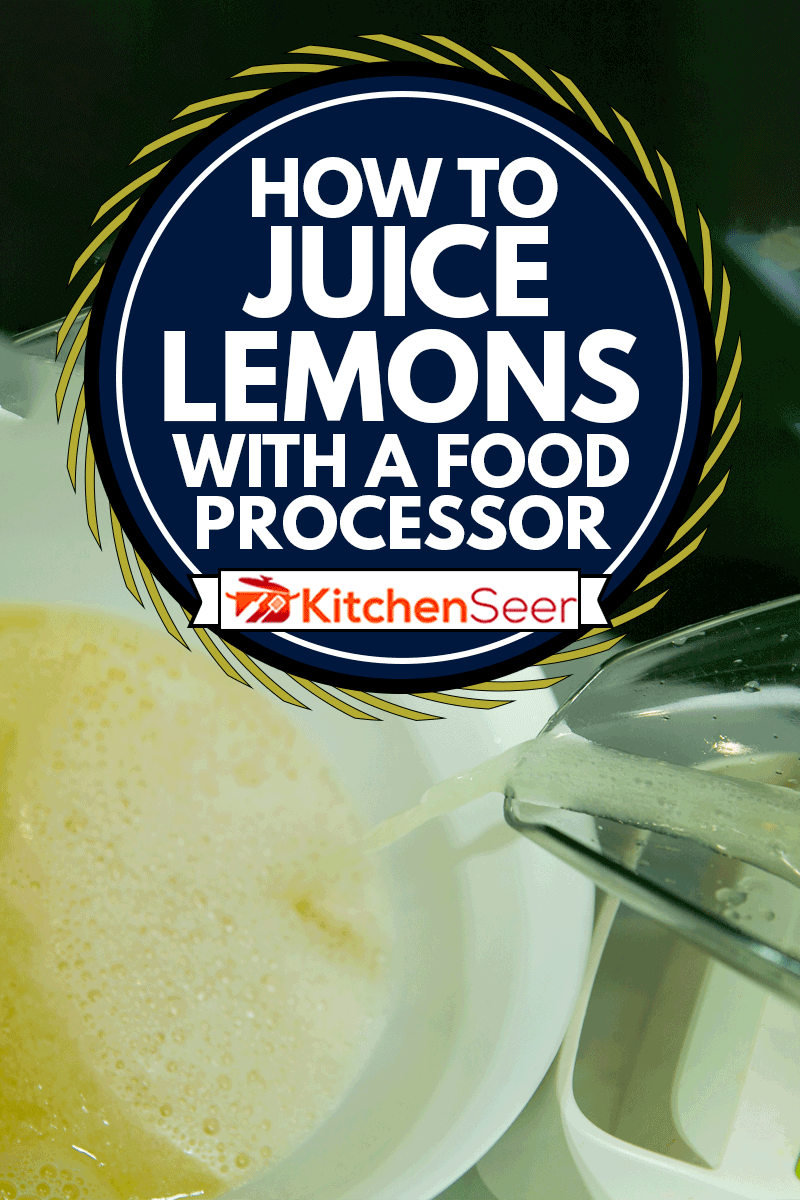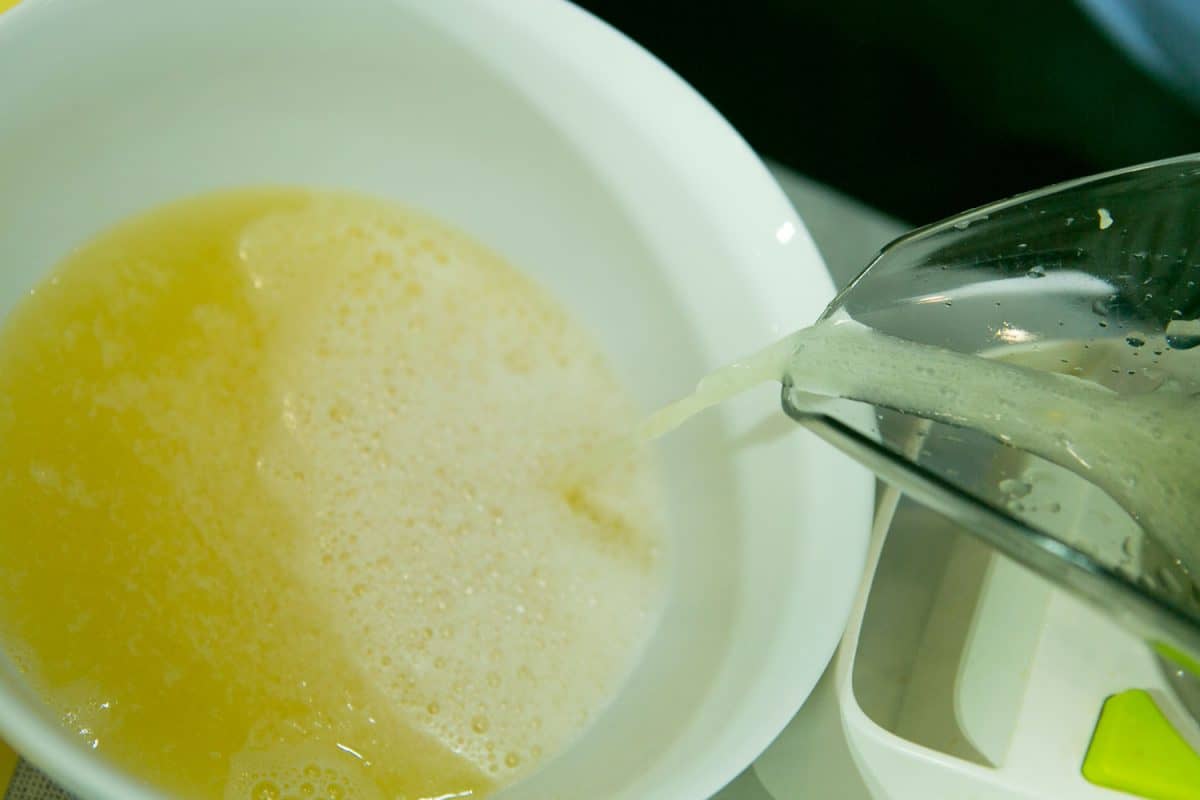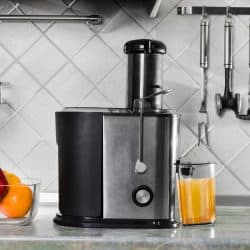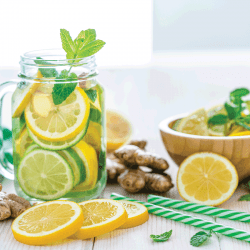Juicing many lemons may seem like a daunting task. You may wonder how you can use your food processor to get the job done! We have thoroughly researched this question and have found some answers for you.
To make lemon juice in your processor, you will need a citrus peeler or paring knife, a nut milk bag or strainer, and preferably an electric food processor. Next, follow these steps:
- Peel the lemons
- Assemble the food processor
- Puree the lemons
- Strain the lemons
- Store the pulp to use for your recipe
Using your processor to juice your lemons can definitely help you save time and get more juice out of your fruit. Keep reading as we discuss each step and break down the differences between juicing and processing.

What's The Difference Between A Food Processor And A Juicer?
Though both machines will process wet items, the results are quite different. A juicer can be used for vegetables, fruits, and nuts to produce a juice with little to no pulp. A food processor is more versatile and can break down almost any type of food into a puree or crumbs, leaving fiber or pulp in the end product. When using a food processor, any extraction or separation would occur manually after using the machine.
What Is a Food Processor
A food processor can be electric or manual. Though there are a variety of processors available, with different attachments, the basic construction is the same. They have a motor or manual lever, a blade, and a container with a lid. For more on the construction of a food processor, read our article "What are the Parts of a Food Processor?"
A processor comes in a wide variety of sizes according to the volume it can process and can be used to chop, slice, crush and puree most foods. A processor is the best choice for everything from chopping salads to making baby food or dips like hummus. For juicing lemons, a larger capacity such as an 8 or 10 cup processor is best.
Click here to see this 10 cup food processor on Amazon.
Click here to see this example of a manual food processor on Amazon.
What Is A Juicer?
A juicer's goal is quite different than a processor, and its construction has more parts. Juicers are not sold by capacity like food processors; rather, they are described in speed, watts, and method.
Juicers function by masticating, crushing, or spinning fruits and vegetables against a mesh strainer. The fiber is pushed or spun out of a designated spout or into a covered container, while liquid comes out of a spout into another container. The puree and straining are handled all in one system.
Juicers are mainly used when wanting to use the end product for drinking. The process maintains the quality, flavor, and nutrition of the resulting juice.
There are two main types of juicers. A slow juicer, which is a masticating juicer that chews or presses produce slowly against a mesh filter, is thought to maintain nutritional integrity and taste by introducing little to no heat to the process. There is also very little oxygen introduced, resulting in a juice that can be stored for up to 72 hours.
Click here to see this slow cold press juicer on Amazon.
The more popular version of the juicer is the centrifugal juicer. Though it uses a high-powered spinning action that produces higher heat and more oxygen, most users enjoy this type of juicer for the speed at which it will juice fruits and vegetables.
Click here to see this centrifugal juicer on Amazon.
How Do You Make Lemon Juice In A Food Processor?
The methods for making lemon juice in your processor may vary slightly in the preparation and straining steps, but the basics steps will be the same.
Do You Need To Peel Lemons Before Juicing?
The choice of whether to peel all of your lemons or to leave a few unpeeled will depend on what your intended use is for your juice. Unless you are juicing for medicinal purposes or for a recipe that requires a more intense flavor, you will want to peel your lemons.
Keep in mind that most lemons contain oils and chemicals in their peels that can make the resulting juice quite bitter. For a smoother tasting juice, you will want to remove most of the pith as well. There are many ways to peel a lemon. When peeling a large number of lemons, we recommend using a citrus peeler or paring knife.
Click here to see this citrus peeler on Amazon.
Click here to see this paring knife on Amazon.
This video demonstrates using a citrus peeler, while a paring knife can be used in much the same way. Use a paring knife to remove more pith.
Assemble the food processor
Most food processors require that the blade be inserted first before adding the lemons. Use the basic processor blade for pureeing your lemons. Using the slicing discs that come with most units will result in the puree gathering at the top and overflowing your machine.
Puree the lemons
Use the pulse, mix or chop function on your processor to puree your lemons. Although 1-minute is long enough, the longer you let the machine go, the easier it will be to extract the juice in the straining step. To avoid heating your lemon, most machines should not go longer than 2 minutes. Always consult the user manual for how long the processor can be kept running.
The consistency to look for is a frothy uniform puree. This video shows how to use your processor to make juice which is used for lemonade.
Strain The Lemons
To strain your lemons, choose a strainer for more pulpy juice, or use a nut milk bag or cheesecloth for a finer, low pulp juice. If you choose to strain, consider using a strainer with a damper or pestle to push the pulp through to get the most juice out of your lemons.
Click here to see this strainer with a pestle on Amazon.
To use a nut milk bag or cheesecloth, drape over a container and secure with a rubber band or tie. Fill with pulp and then remove the bag from the side of the container. Squeeze in a twisting motion downward until juice is fully extracted into the container.
Make sure to reference the size of the bag or cloth since they can come in a wide variety of sizes. You will want a larger size so that it can drape over the sides of the container. The below nut milk bag is 10 by 12 inches.
Click here to see this nut milk bag on Amazon.
Store The Pulp To Use For Another Recipe
Now that you have your lemon juice, you may be wondering what you can do with the pulp. The uses for leftover lemon pulp and fiber are endless! Store the pulp in ice cube trays to use in the future. It will keep for months.
Some favorite ways to use the pulp are to blend it into smoothies or make tea, for an extra vitamin boost. Add excitement to a muffin or bread recipe. Add lemon pulp to vanilla box cake to add a special flair to a convenient favorite.
How Do You Juice Large Amounts Of Lemons?
A processor can juice many lemons at once, but even the larger capacity processors have their limits. If you are looking to juice a large number of lemons, or you need to get the most juice without having to go through the peeling and straining steps, consider getting a citrus press or juicer.
To use these machines, simply chop your citrus in half. Press the halves in the machines until the juice is completely extracted. The time saved by skipping preparation and straining results in being able to produce more juice in less time. You will often see those who sell lemonade at the fair or in a juice shop use a juice press or citrus juicer like the ones below.
Click here to see this commercial press on Amazon.
What Can You Do With Leftover Lemon Juice

Now that you know how to juice lemons with a processor and how to store the leftover pulp, you may be wondering what to do with the leftover juice. Like the pulp, store the juice in ice cubes to use in recipes or even to flavor your water. Thaw lemon juice cubes and add water and sweetener of your choice to taste, and you'll have a fresh glass of old-fashioned lemonade whenever the mood strikes.
You may also be interested in these articles:
Does Microwaving Lemons And Limes Make Them Juicier?
Kitchen Aid Food Processor Not Working – What Could Be Wrong?















![Hand zesting lemon using a grater, How To Zest A Lemon [5 Ways, Inc. Without A Grater]](https://kitchenseer.com/wp-content/uploads/2021/09/Hand-zesting-lemon-250x250.jpg)
![Kitchen knife with black handle on wooden board made of beech. What Can You Cut With A Paring Knife [How About Meat]](https://kitchenseer.com/wp-content/uploads/2021/09/Kitchen-knife-with-black-handle-on-wooden-board-made-of-beech.-What-Can-You-Cut-With-A-Paring-Knife-How-About-Meat-250x250.png)